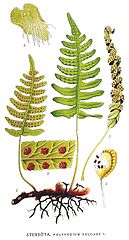Paprotkowate
 Paprotka zwyczajna | |
| Systematyka[1][2] | |
| Domena | |
|---|---|
| Królestwo | |
| Podkrólestwo | |
| Nadgromada | |
| Gromada | |
| Klasa | |
| Podklasa | |
| Rząd | |
| Rodzina |
paprotkowate |
| Nazwa systematyczna | |
| Polypodiaceae Bercht. & J.Presl 1820 | |



Paprotkowate (Polypodiaceae Bercht. & J. Presl) – rodzina roślin należąca do klasy paproci. Zalicza się do niej ok. 1000 gatunków, zgrupowanych w 50 rodzajach.
Systematyka
[edytuj | edytuj kod]
W systemie Smitha i in. (2006) rodzina w rzędzie paprotkowców (Polypodiales)[3]. W systemie PPG I (2016) rodzina w obrębie podrzędu Polypodiineae H.Schneid. & C.J.Rothf. 2016 odpowiadającemu kladowi „eupolypods I” w systemie Smitha i in. (2006)[2].
| paprotkowce |
| ||||||||||||||||||||||||||||||||||||||||||||||||||||||||||||||||||||||||||||||||||||||||||||||||||||||||||||||||||||||||||||||||||||||||||||||||||||||
- Podział rodziny na podrodziny i rodzaje[2]
podrodzina: Loxogrammoideae H.Schneid. in Christenhusz et al., Phytotaxa 19: 18. 2011
- Dictymia J.Sm., Companion Bot. Mag. 72: 16. 1846
- Loxogramme (Blume) C.Presl, Tent. Pterid.: 214–215, pl.9, f.8. 1836
podrodzina: Platycerioideae B.K.Nayar, Taxon 19: 233. 1970
- Platycerium Desv., M_em. Soc. Linn. Paris 6(3): 213. 1827 – płaskla
- Pyrrosia Mirb., Hist. Nat. Veg. 3: 471. 1803 – pyrozja
podrodzina: Drynarioideae Crabbe, Jermy & Mickel, Fern Gaz. 11: 156. 1975
- Drynaria (Bory) J. Sm. (w tym Aglaomorpha Schott, Gen. Fil.: t.19. 1836) – drynaria
- Arthromeris (T.Moore) J.Sm., Hist. Fil.: 110. 1875
- Gymnogrammitis Griff., Icon. Pl. Asiat. 2: t.129, f.1. 1849
- Paraselliguea Hovenkamp, Blumea 45(2): 376. 2000
- Polypodiopteris C.F.Reed, Amer. Fern J. 38: 87. 1948
- Selliguea Bory, Dict. Class. Hist. Nat. 6: 587–588. 1824
podrodzina: Microsoroideae B.K.Nayar, Taxon 19(2): 233. 1970
- Goniophlebium (Blume) C.Presl, Tent. Pterid.: 185, pl.7, f.13–14. 1836
- Lecanopteris Reinw. ex Blume, Enum. Pl. Javae 2: 120. 1828
- Lemmaphyllum C.Presl, Abh. Koenigl. Bohm. Ges. Wiss. Ser. 5 6: 517–518. 1851
- Lepidomicrosorium Ching & K.H.Shing, Bot. Res. Academia Sinica 1(1): 1–14, pl.1–5. 1983
- Lepisorus (J.Sm.) Ching, Bull. Fan Mem. Inst. Biol. Bot. 4(3): 47, 56–58. 1933
- Leptochilus Kaulf., Enum. Filic.: 147, pl.1, f.10. 1824
- Microsorum Link, Hort. Berol. 2: 110. 1833
- Neocheiropteris Christ, Bull. Soc. Bot. France 52 (Mem. 1): 21. 1905
- Neolepisorus Ching, Bull. Fan Mem. Inst. Biol. Bot. 10(1): 11–12. 1940
- Paragramma (Blume) T.Moore, Index Filic. xxxii. 1857
- Thylacopteris Kunze ex J.Sm., Hist. Fil.: 87. 1875
- Tricholepidium Ching, Acta Phytotax. Geobot. 29 (1–5): 41. 1978
podrodzina: Polypodioideae Sweet, Hort. Brit.: 460. 1826.
- Campyloneurum C.Presl, Tent. Pterid.: 189. 1836
- Microgramma C.Presl, Tent. Pterid.: 213. 1836
- Niphidium J.Sm., Hist. Fil.: 99. 1875
- Pecluma M.G.Price, Amer. Fern J. 73(4): 109. 1983
- Phlebodium (R.Br.) J.Sm., J. Bot. (Hooker) 4: 58. 1841 – flebodium
- Pleopeltis Humb. & Bonpl. ex Willd., Sp. Pl., ed. 4, 5: 211. 1810
- Pleurosoriopsis Fomin, Izv. Kievsk. Bot. Sada 11: 8. 1930
- Polypodium L., Sp. Pl. 2: 1082. 1753 – paprotka
- Serpocaulon A.R.Sm., Taxon 55(4): 924–927, f. 3-4. 2006
podrodzina: Grammitidoideae Parris & Sundue, 2016
- Acrosorus Copel., Philipp. J. Sci. 1(Suppl. 2): 158–159. 1906
- Adenophorus Gaudich., Ann. Sci. Nat. (Paris) 3: 508. 1824
- Alansmia M.Kessler, Moguel, Sundue & Labiak, Brittonia 63(2): 238. 2011
- Archigrammitis Parris, Fern Gaz. 19(4): 135–136. 2013
- Ascogrammitis Sundue, Brittonia 62(4): 361. 2010
- Calymmodon C.Presl, Tent. Pterid.: 203–204, pl.9, f.1. 1836
- Ceradenia L.E.Bishop, Amer. Fern J. 78(1): 2. 1988
- Chrysogrammitis Parris, Kew Bull. 3(4): 909. 1998
- Cochlidium Kaulf., Berlin. Jahrb. Pharm. Verbundenen Wiss. 21: 36. 1820
- Ctenopterella Parris, Gard. Bull. Singapore 58(2): 234. 2007
- Dasygrammitis Parris, Gard. Bull. Singapore 58(2): 238. 2007
- Enterosora Baker, Timehri 5: 218. 1886
- Galactodenia Sundue & Labiak, Syst. Bot. 37(2): 340. 2012
- Grammitis Sw., J. Bot. (Schrader) 2: 3, 17. 1801
- Lellingeria A.R.Sm. & R.C.Moran, Amer. Fern J. 81 (3): 76. 1991
- Leucotrichum Labiak, Taxon 59(3): 915. 2010
- Lomaphlebia J.Sm., Hist. Fil.: 182. 1875
- Luisma M.T.Murillo & A.R.Sm., Novon 13(3): 313–316, f. 1. 2003
- Melpomene A.R.Sm. & R.C.Moran, Novon 2(4): 426. 1992
- Micropolypodium Hayata, Bot. Mag. (Tokyo) 42 (449): 341. 1928
- Moranopteris R.Y.Hirai & J.Prado, Taxon 60(4): 1127. 2011
- Mycopteris Sundue, Brittonia 66(2): 175, f.1–2. 2013
- Notogrammitis Parris, New Zealand J. Bot. 50(4): 465. 2012
- Oreogrammitis Copel., Philipp. J. Sci. 12: 64. 1917
- Prosaptia C.Presl, Tent. Pterid.: 165–166, pl.6, f.19, 25. 1836
- Radiogrammitis Parris, Gard. Bull. Singapore 58 (2): 240. 2007
- Scleroglossum Alderw., Bull. Jard. Bot. Buitenzorg, ser. 2, 2(7): 37–39. 1912
- Stenogrammitis Labiak, Brittonia 63(1): 141, f.1A–M, 2A–F. 2011
- Terpsichore A.R.Sm., Novon 3(4): 479. 1993
- Themelium (T.Moore) Parris, Kew Bull. 52(3): 737. 1997
- Tomophyllum (E.Fourn.) Parris, Gard. Bull. Singapore 58(2): 245. 2007
- Xiphopterella Parris, Gard. Bull. Singapore 58(2): 249. 2007
- Zygophlebia L.E.Bishop, Amer. Fern J. 79(3): 107. 1989
Rodzaj o niejasnej pozycji systematycznej:
- Synammia C.Presl, Tent. Pterid.: 212, t.9, f.11. 1836
Przypisy
[edytuj | edytuj kod]- ↑ Michael A. Ruggiero i inni, A Higher Level Classification of All Living Organisms, „PLOS One”, 10 (4), 2015, art. nr e0119248, DOI: 10.1371/journal.pone.0119248, PMID: 25923521, PMCID: PMC4418965 [dostęp 2021-02-28] (ang.).
- ↑ a b c d The Pteridophyte Phylogeny Group. A community-derived classification for extant lycophytes and ferns. „Journal of Systematics and Evolution”. 54 (6), s. 563–603, 2016. DOI: 10.1111/jse.12229.
- ↑ Smith, A. R., K. M. Pryer, E. Schuettpelz, P. Korall, H. Schneider & P. G. Wolf. A classification for extant ferns. „Taxon”. 55 (3), s. 705–731, 2006. (ang.).
- ↑ Samuli Lehtonen. Towards Resolving the Complete Fern Tree of Life. „PLoS ONE”. 6, 10, s. e24851, 2011. DOI: 10.1371/journal.pone.0024851.
- ↑ Carl J. Rothfels, Anders Larsson, Li-Yaung Kuo, Petra Korall, Wen- Liang Chiou, Kathleen M. Pryer. Overcoming Deep Roots, Fast Rates, and Short Internodes to Resolve the Ancient Rapid Radiation of Eupolypod II Ferns. „Systematic Biology”. 61, 1, s. 70, 2012.
